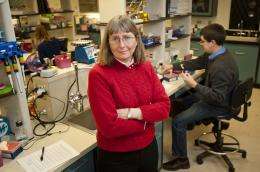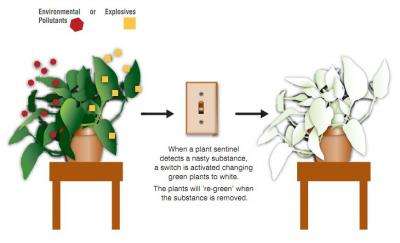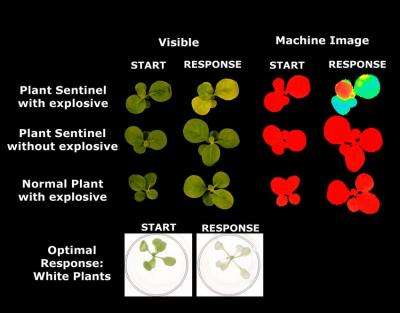Biologists produce plants that detect environmental contaminants, explosives (w/ Video)

(�鶹��ԺOrg.com) -- A Colorado State University biologist has shown that plants can serve as highly specific detectors for environmental pollutants and explosives.
Professor June Medford and her team in the Department of Biology enabled a computer-designed detection trait to work in a plant by rewiring its natural signaling process so the plant turns from green to white when chemicals are detected in air or soil. This work – an important step in a long process - could eventually be used for a wide range of applications such as security in airports or shopping malls, or monitoring for pollutants such as radon in a home.

“The idea to make detector plants comes directly from nature,” Medford said. “Plants can’t run or hide from threats, so they’ve developed sophisticated systems to detect and respond to their environment. We’ve ‘taught’ plants how to detect things we’re interested in and respond in a way anyone can see, to tell us there is something nasty around.”
The research appears today in the peer-reviewed journal PLoS ONE. Financial support for the research was provided by the Defense Advanced Research Projects Agency, or DARPA, the Office of Naval Research, the Bioscience Discovery Evaluation Grant Program through the Colorado Office of Economic Development and International Trade, the National Science Foundation, the Department of Homeland Security Science and Technology Directorate and Gitam Technologies.
"Plant sentinels engineered to detect explosives may ultimately help us protect our troops from improvised explosive devices (IED's)," said Linda Chrisey, program officer for the Naval Biosciences and Biocentric Technology Program at the Office of Naval Research.
Medford and her team also recently received a three-year, $7.9 million grant from the Defense Threat Reduction Agency in the U.S. Department of Defense to take the discovery described in PLoS ONE from her CSU research laboratory to the “real-world.”
Based on research so far, detection abilities of these plants are similar to or better than those of dogs, Medford said. The detection traits could be used in any plant and could detect multiple pollutants at once – changes that can also be detected by satellite.
“Dr. Medford’s research illustrates that basic changes in scientific understanding can be applied to important problems such as environmental protection and homeland security,” said Bill Farland, vice president for Research at Colorado State and formerly top scientist at the Environmental Protection Agency.
Computational design of Medford’s detection trait was initially done in collaboration with Professor Homme Hellinga at Duke University and more recently with Professor David Baker at the University of Washington.

How it works: The Baker and Hellinga laboratories used a computer program to redesign naturally occurring proteins called receptors. These re-designed receptors specifically recognize a pollutant or explosive. Medford’s lab then modifies these computer redesigned receptors to function in plants, and targets them to the plant cell wall where they can recognize pollutants or explosives in the air or soil near the plant. The plant detects the substance and activates an internal signal that causes the plant to lose its green color, turning the plants white.
Moving forward, Medford will use her team of some 30 undergraduate and graduate students and post-doctoral fellows to focus on such factors as speeding up detection time. The initial or first-generation plants respond to an explosive in hours, but improvements are underway to reduce the response time to a few minutes.
More information: Plos ONE article: %3Adoi%2F10.1371%2Fjournal.pone.0016292
Provided by Colorado State University

















